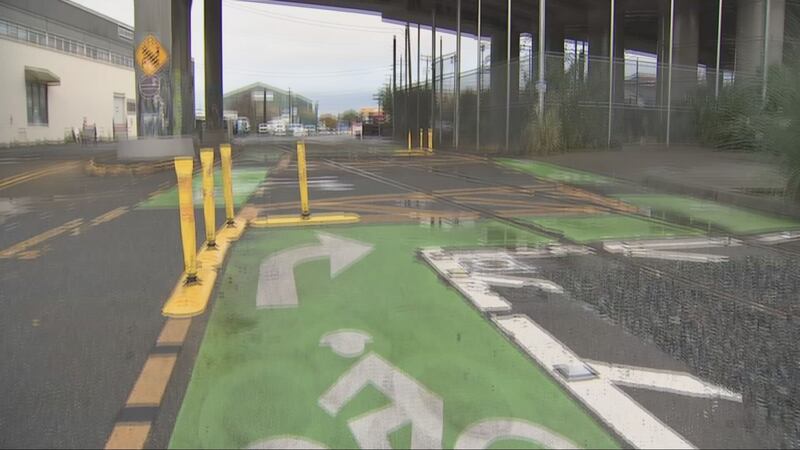SEATTLE — One of Seattle’s most dangerous stretches of bike path in Ballard could finally be fixed. There’s a small stretch on Ballard’s so-called “missing link” along the Burke-Gilman Trail where railroad tracks cross directly through the bike path, creating a hazard. Cyclists who fought for a fix might finally get their wish.
When it comes to fixing that small part of the missing link, the City of Seattle has tried to do things, such as putting gravel around the tracks. They’ve marked where you can cross at 90 degrees and there are even lights on the ground, but that hasn’t stopped people from wiping out in the area.
Jonathan Sirois commutes through the area several days a week and knows the hazards of the tracks.
“The tracks just need to go away. There’s no reason for them to be here. When I first started riding, my wife both crashed somewhere along here like 10 years ago when it was wet,” said Sirois.
Commuter cyclists were cruising over, around, and through the section of the bike path Wednesday morning.
Commuter Mark Clagg knows the area well, also traveling through it by bike several days a week. He also knows navigating the tracks can be tricky.
“I’ve seen a lot of people go down over the years,” said Clagg.
Seattle City Council announced this week that it passed legislation to fix the notoriously dangerous section of the bike path — the area’s rail tracks will be paved over.
Scott Carty owns a business near the bike path and doesn’t need to cycle to know it’s dangerous.
“I have seen countless people just bite it. I’ve seen people wipe out and rushed over to try to help them and lift them up, and thankfully, most of the people have been OK and brushed it off,” said Carty.
He says that the fix for cyclists has been long overdue.
“It’s the people that are out on the ‘Hey, let’s go for a ride on the Burke-Gilman Trail’ — they don’t know and you need it to be accessible to everyone,” said Carty.
For cyclists like Sirois, a rough ride that has caused its own share of injuries will be a thing of the past — paving a connection to make part of the Burke-Gilman Trail a little better.
“Land is so valuable in this city that we take a chunk of land and it’s just sitting here like this, not being used to actually move people or (for) park space — it just doesn’t make sense,” Sirois said.
Councilmember Dan Strauss (District 6 - Northwest Seattle) also favors fixing the notoriously dangerous section of the Burke-Gilman Trail.
“I am excited we can finally make one of the most dangerous railroad crossings in our city safe for people riding bikes. When I was in grade school I watched someone crash on these tracks the very first time I rode my bike on this section of the missing link and I am glad we can finally put a stop to this,” said Strauss. “I am proud to deliver this outcome for District 6 and our city by bringing people together to find common ground.”
“We’re thrilled to improve the paving and enhance safety for people riding bikes under the Ballard Bridge and we are moving forward immediately to do so,” said Francisca Stefan, Senior Deputy Director for Seattle Department of Transportation. “Our dedication to improving safety and accessibility for all members of our community remains steadfast, and we eagerly anticipate the positive transformation these changes will bring to our city’s cycling network.”
According to the Seattle Department of Transportation’s blog post, the legislation passed by the city council strikes a deal that will allow Ballard Terminal Railroad to transfer ownership of the line to Meeker Southern Railroad. In doing so, it will allow SDOT to make long-sought safety improvements, which include paving over the dangerous section of rail.
SDOT is expected to complete the paving work this week but the work is weather-dependent and exact timing is subject to change. While this work is taking place, bike riders will need to detour around the work zone via 14th Avenue Northwest and Northwest 46th Street.
The new asphalt covering will allow people to bike through the area without crossing the tracks at a sharp angle. It will help transform the way bikers navigate through the area, reducing the need for bikers to slow down to cross the tracks.
©2023 Cox Media Group








